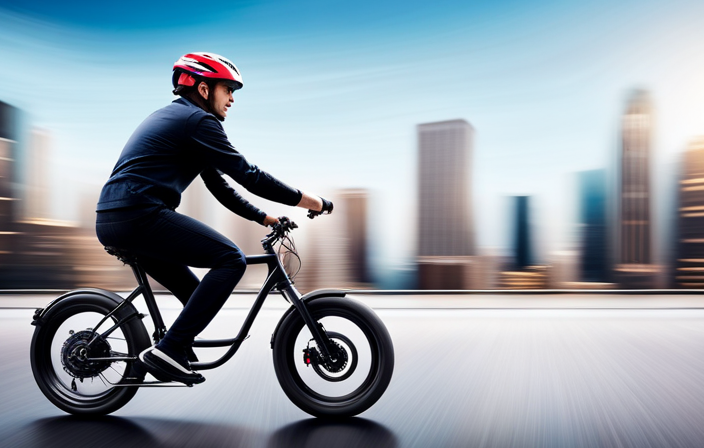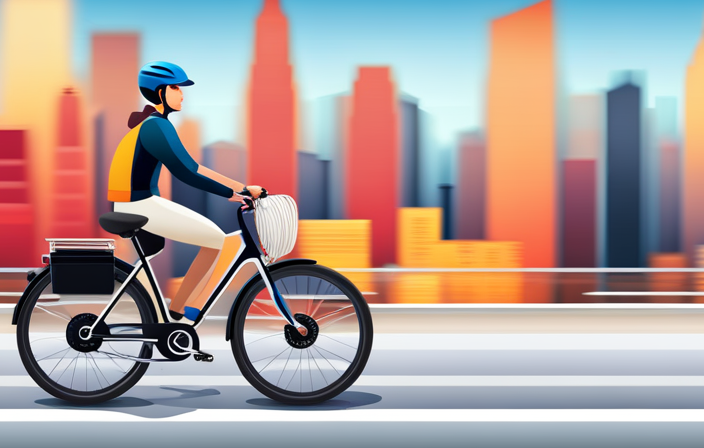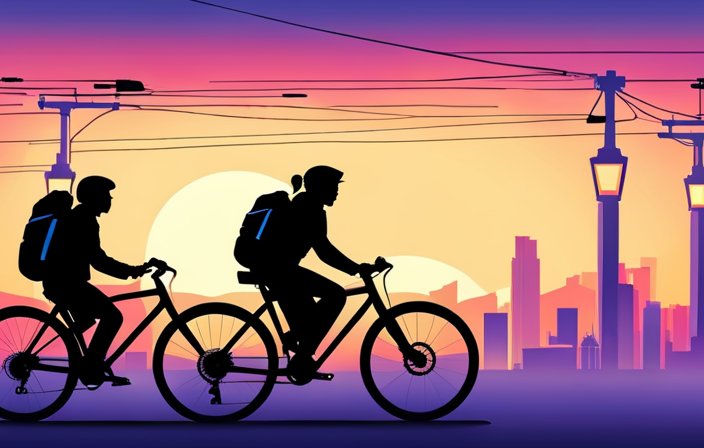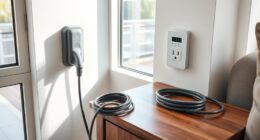As I pedal along the city streets, the wind whips through my hair and the thrill of speed rushes through my veins. Electric bikes have become a popular mode of transportation and recreation, but have you ever wondered how fast they are allowed to go?
In this article, I will delve into the regulations surrounding electric bike speeds in different countries and provide tips for maintaining a safe and legal speed. Get ready to strap on your helmet and join me on this journey to discover the limits of electric bike speed.
Key Takeaways
- Understanding electric bike speed classifications and staying within the legal speed limit is crucial for choosing the right bike and ensuring alignment with preferences.
- Familiarize yourself with local speed limits and regulations, and adjust your pedaling accordingly to stay within the legal limit.
- Use a combination of pedaling and motor assistance to maintain a safe and legal speed, and regularly check your speedometer to avoid exceeding the speed limit.
- Enjoy the benefits of electric bikes responsibly by staying within the speed limits, enhancing safety, and complying with regulations.
Understanding Electric Bike Speed Regulations
The maximum speed limit for an electric bike is typically around 20 miles per hour. However, it is important to note that this speed can vary depending on certain factors.
Electric bike speed records have shown that some models can reach speeds of up to 28 miles per hour or even higher.
The speed performance of an electric bike is influenced by several factors.
Firstly, the power of the motor plays a significant role. Higher wattage motors generally provide more speed.
Additionally, the weight of the bike and the rider can affect the top speed. Lighter bikes with lighter riders tend to have better speed performance.
The terrain and road conditions also impact the speed, as steep hills or rough surfaces can slow down an electric bike.
Ultimately, it is essential to adhere to local speed regulations to ensure safety while riding an electric bike.
Speed Limits for Electric Bikes in the United States
In the United States, there are speed limits for e-bikes. Understanding electric bike speed classifications is crucial to ensure compliance with these regulations. Electric bikes are classified into three categories based on their maximum speed: Class 1, Class 2, and Class 3.
- Class 1 e-bikes have a maximum speed of 20 miles per hour and are equipped with a pedal-assist system.
- Class 2 e-bikes also have a maximum speed of 20 miles per hour but are equipped with a throttle that allows for motor-only propulsion.
- Class 3 e-bikes have a maximum speed of 28 miles per hour and are equipped with a pedal-assist system.
These speed restrictions for electric bikes provide several benefits. Firstly, they enhance safety by ensuring that e-bikes do not travel at excessive speeds, reducing the risk of accidents. Additionally, speed limits help to maintain harmony between e-bikes and traditional bicycles on shared pathways. Lastly, speed restrictions promote responsible riding and discourage reckless behavior.
Speed Restrictions for Electric Bikes in Europe
When riding an e-bike in Europe, it’s important to be aware of the speed restrictions in place. Understanding e-bike speed classes can help ensure you ride within the legal limits.
In Europe, e-bikes are classified into different categories based on their maximum assisted speed. The most common classes are 25 km/h (15.5 mph) and 45 km/h (28 mph).
E-bikes in the 25 km/h class are allowed on bike paths and trails, while those in the 45 km/h class are typically treated like mopeds and require a license and insurance.
It’s important to note that exceeding the speed limits not only puts you at risk of legal consequences, but it can also have an impact on your e-bike’s battery life. Higher speeds consume more power, reducing the overall distance you can travel on a single charge.
So, always ride responsibly and within the designated speed limits to maximize your e-bike’s battery life.
Maximum Speeds for Electric Bikes in Asia
Speed restrictions for e-bikes in Asia vary depending on the country and its specific regulations.
In Japan, electric bike speed limits are set at a maximum of 24 km/h (15 mph). This ensures the safety of riders and pedestrians on the roads. However, it’s important to note that different prefectures in Japan may have their own specific regulations regarding electric bike speeds.
In China, the maximum speed of an electric bike is typically limited to 20 km/h (12 mph) due to safety concerns. However, it’s worth mentioning that there are several factors that can affect the speed of an electric bike in China. These factors include battery power, weight of the rider, terrain, and road conditions. It’s essential for riders to be aware of these factors and to adhere to the speed limits set by the local authorities to ensure a safe and enjoyable riding experience.
Speed Regulations for Electric Bikes in Australia
You should be aware of the speed regulations for electric bikes in Australia. Understanding electric bike speed classifications is important to ensure you are riding within the legal limits.
In Australia, electric bikes are classified as either pedal-assist or throttle-assist. Pedal-assist electric bikes have a maximum speed of 25 kilometers per hour (15.5 miles per hour) when the rider is pedaling. On the other hand, throttle-assist electric bikes have a maximum speed of 25 kilometers per hour (15.5 miles per hour) even without pedaling.
It’s worth noting that exceeding these speed limits can result in fines and other penalties.
Additionally, using electric bikes for transportation offers numerous benefits. They are eco-friendly, cost-effective, and provide a convenient alternative to cars and public transportation.
So, make sure to abide by the speed regulations and enjoy the benefits of using electric bikes for transportation in Australia.
Safety Considerations for Riding an Electric Bike
One important factor to consider while riding an electric bike is ensuring your safety. Here are some key safety considerations to keep in mind:
-
Always wear a helmet: Wearing a helmet is crucial, regardless of the speed at which you’re riding. It can protect your head in the event of a fall or collision, reducing the risk of serious injury.
-
Pay attention to the electric bike speedometer: Electric bikes often come equipped with speedometers. It’s important to keep an eye on your speed to ensure you’re not exceeding the legal limits and riding within a safe range for your surroundings.
-
Obey traffic rules: Just like any other vehicle, electric bikes are subject to traffic rules. Follow traffic signals, yield to pedestrians, and stay in designated bike lanes whenever possible.
-
Be aware of your surroundings: Stay alert and aware of your surroundings while riding an electric bike. Be mindful of other vehicles, pedestrians, and potential hazards on the road.
-
Maintain your electric bike: Regularly inspect and maintain your electric bike to ensure it’s in good working condition. Check the brakes, lights, tires, and other components to ensure they are functioning properly.
Remember, prioritizing safety while riding an electric bike is essential for an enjoyable and worry-free experience.
Tips for Maintaining a Safe Speed on an Electric Bike
To maintain a safe speed on an electric bike, it’s important to regularly monitor your speedometer. This will help you keep track of your speed and ensure that you are within the allowed limits.
Additionally, maintaining proper acceleration is crucial. Gradually increase your speed rather than suddenly accelerating, as this can lead to loss of control.
It’s also important to avoid excessive speed. While electric bikes can go faster than traditional bikes, it’s essential to ride at a speed that is safe for the road conditions and your skill level. Be aware of the speed limits in your area and adjust your speed accordingly.
Remember, safety should always be your top priority when riding an electric bike.
Differences Between Class 1, 2, and 3 Electric Bikes
If you’re considering an electric bike, it’s important to understand the differences between Class 1, 2, and 3 models. These classifications are based on the speed capabilities of the electric bike and can significantly impact your riding experience.
Class 1 electric bikes are equipped with pedal-assist up to 20 mph, providing a smooth and controlled ride.
Class 2 models have a throttle that can propel the bike up to 20 mph without any pedaling required.
Lastly, Class 3 electric bikes offer pedal-assist up to 28 mph, allowing for a faster and more exhilarating ride.
Understanding these speed classifications is crucial because it ensures that you choose an electric bike that aligns with your needs and preferences.
The benefits of electric bike speed control are numerous, including enhanced safety, improved efficiency, and the ability to regulate your speed in different riding conditions.
Whether you prefer a leisurely cruise or a speedy commute, electric bike speed control provides the flexibility and control you desire.
How to Stay Within the Legal Speed Limit on an Electric Bike
To stay within the legal speed limit on an e-bike, it’s important to be aware of the speed capabilities and adjust your pedaling accordingly. Electric bike speed limits vary depending on the class of the bike and the specific regulations in your area.
In general, Class 1 electric bikes are limited to a top speed of 20 mph, while Class 2 electric bikes have a top speed of 20 mph but can also be operated using a throttle without pedaling. Class 3 electric bikes have a higher top speed of 28 mph, but they are usually limited to pedal-assist mode.
To ensure you are within the legal speed limit, here are some tips:
- Familiarize yourself with the electric bike speed limits in your area.
- Use a combination of pedaling and motor assistance to maintain a safe and legal speed.
- Regularly check your speedometer to ensure you are not exceeding the speed limit.
By following these guidelines, you can enjoy the benefits of an electric bike while staying within the legal requirements for electric bike speed.
Advantages of Electric Bikes for Commuting and Recreation
Enjoy the convenience and fun of commuting and recreation with an e-bike! Electric bikes offer numerous advantages for both everyday transportation and leisurely rides. Not only are they eco-friendly and cost-effective, but they also provide a range of safety considerations. With an electric bike, you can effortlessly navigate through traffic and easily tackle hills, making your commute a breeze. Additionally, electric bikes allow you to choose the level of assistance you need, giving you the flexibility to adjust your speed and effort according to your preferences. Safety is further enhanced with features like lights, mirrors, and responsive brakes, ensuring a smooth and secure ride. Whether you are commuting to work or exploring new trails, an electric bike offers the perfect blend of convenience, efficiency, and enjoyment.
| Advantages | Safety Considerations |
|---|---|
| Eco-friendly | Lights and reflectors |
| Cost-effective | Responsive brakes |
| Easy navigation through traffic | Mirrors for better visibility |
| Effortlessly tackle hills | Stable and sturdy construction |
Frequently Asked Questions
Can I modify my electric bike to go faster than the legal speed limit?
Yes, you can modify your electric bike to go faster than the legal speed limit. However, it is important to note that doing so can have legal consequences.
Are there any penalties for riding an electric bike above the allowed speed limit?
There are penalties for speeding on electric bikes, which vary depending on the jurisdiction. It is important to adhere to the legal speed limits for electric bikes to avoid fines, points on your license, or even the possibility of having your bike confiscated.
Are there any specific safety gear requirements for riding an electric bike at higher speeds?
There are specific safety gear requirements for riding an electric bike at higher speeds. A helmet is required to ensure head protection. Additionally, speed limit enforcement is important to ensure the safety of riders and others on the road.
Are there any additional restrictions for riding electric bikes in certain areas, such as parks or bike lanes?
When it comes to electric bike safety and regulations, there may be additional restrictions in certain areas such as parks or bike lanes. It’s important to familiarize yourself with local laws to ensure you’re riding within the guidelines.
Are there any age restrictions for riding an electric bike at higher speeds?
There are age restrictions for riding an electric bike at higher speeds. The specific age limit may vary depending on local regulations. It is important to follow the speed limits set by the authorities to ensure safety.
Conclusion
In conclusion, understanding the speed regulations for electric bikes is crucial for ensuring a safe and enjoyable riding experience.
Across different regions, there are variations in speed limits imposed on electric bikes. For instance, in the United States, electric bikes are typically limited to a maximum speed of 20 mph. However, in Europe, the maximum speed is often restricted to 15.5 mph.
One interesting statistic is that in Asia, particularly in countries like China and Japan, electric bikes can reach speeds of up to 28 mph.
It’s important to familiarize oneself with local regulations and always maintain a safe speed while riding an electric bike.
By adhering to these guidelines, individuals can fully enjoy the advantages of electric bikes for commuting and recreation.









